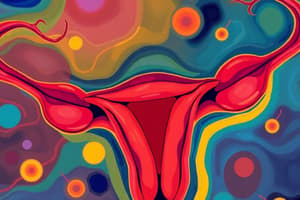Podcast
Questions and Answers
What structures are responsible for transporting sperm from the testis to the outside of the body?
What structures are responsible for transporting sperm from the testis to the outside of the body?
- Urethra and vas deferens (correct)
- Epididymis and seminal vesicles
- Vasa efferentia and bulbourethral glands
- Rete testis and prostate
Which of the following glands contribute to the composition of seminal plasma?
Which of the following glands contribute to the composition of seminal plasma?
- Epididymis and urethra
- Glans penis and foreskin
- Rete testis, epididymis, and vasa efferentia
- Bulbourethral, prostate, and seminal vesicles (correct)
What is the primary function of the penis in the male reproductive system?
What is the primary function of the penis in the male reproductive system?
- Facilitating insemination through erection (correct)
- Conducting urine from the bladder
- Storage of seminal fluid
- Production of sperm
Which anatomical structure follows the seminiferous tubules in the male reproductive system?
Which anatomical structure follows the seminiferous tubules in the male reproductive system?
Which statement accurately describes the foreskin of the penis?
Which statement accurately describes the foreskin of the penis?
What is the role of Sertoli cells in the male reproductive system?
What is the role of Sertoli cells in the male reproductive system?
Why is the location of the testes outside the abdominal cavity important?
Why is the location of the testes outside the abdominal cavity important?
At what age does the formation of ovum typically cease in women?
At what age does the formation of ovum typically cease in women?
What are Leydig cells responsible for?
What are Leydig cells responsible for?
How many sperm-producing seminiferous tubules are typically found in each testicular lobule?
How many sperm-producing seminiferous tubules are typically found in each testicular lobule?
What is the primary purpose of the scrotum in males?
What is the primary purpose of the scrotum in males?
During spermatogenesis, which type of cell undergoes meiotic divisions to produce sperm?
During spermatogenesis, which type of cell undergoes meiotic divisions to produce sperm?
What is the length range of an adult human testis?
What is the length range of an adult human testis?
Flashcards
Male sex accessory ducts
Male sex accessory ducts
Structures that transport sperm from the testis to the outside via the urethra.
Seminiferous tubules
Seminiferous tubules
Tubules within the testis that connect to the vasa efferentia.
Vas deferens
Vas deferens
Tube carrying sperm from epididymis to ejaculatory duct.
Seminal plasma
Seminal plasma
Signup and view all the flashcards
Penis
Penis
Signup and view all the flashcards
Male reproductive system location
Male reproductive system location
Signup and view all the flashcards
Testis temperature and function
Testis temperature and function
Signup and view all the flashcards
Testis compartments
Testis compartments
Signup and view all the flashcards
Seminiferous tubules function
Seminiferous tubules function
Signup and view all the flashcards
Sertoli cells function
Sertoli cells function
Signup and view all the flashcards
Interstitial cells function
Interstitial cells function
Signup and view all the flashcards
Testicular Lobules
Testicular Lobules
Signup and view all the flashcards
Spermatogenesis
Spermatogenesis
Signup and view all the flashcards
Study Notes
Human Male Reproductive System
- Humans are sexually reproducing and viviparous.
- Reproduction involves gametogenesis (sperm and ovum), insemination, fertilization, zygote formation, blastocyst formation/implantation, embryonic development (gestation), and parturition.
- This process occurs after puberty with significant gender differences. Sperm production continues throughout adulthood, while ovum production ceases around age 50.
- The male reproductive system is located in the pelvis.
- It includes testes, accessory ducts, glands, and external genitalia (penis).
- Testes are housed in the scrotum; temperature regulation is crucial for spermatogenesis.
- Temperature is 2–2.5°C lower than internal body temperature.
- Each adult testis is oval, approximately 4–5 cm long and 2–3 cm wide.
- Each testis has approximately 250 compartments called testicular lobules.
- Each lobule contains highly coiled seminiferous tubules that produce sperm.
- Inside the tubules are two cell types:
- Male germ cells (spermatogonia): undergo meiosis for sperm formation
- Sertoli cells: provide nourishment to germ cells.
- Interstitial spaces contain Leydig cells that synthesize and secrete androgens (male hormones).
- Accessory ducts include:
- Rete testis
- Vasa efferentia
- Epididymis (stores and transports sperm)
- Vas deferens (receives from seminal vesicle, forms ejaculatory duct)
- The urethra originates from the bladder and passes through the penis to the urethral meatus.
- The penis is the male external genitalia; it has erectile tissue for insemination.
- The penis's end is the glans penis, covered by foreskin.
- Accessory glands include paired seminal vesicles, prostate gland, and paired bulbourethral glands.
- Their secretions (seminal plasma) contain fructose, calcium, and enzymes.
- Bulbourethral gland secretions lubricate the penis.
Studying That Suits You
Use AI to generate personalized quizzes and flashcards to suit your learning preferences.




